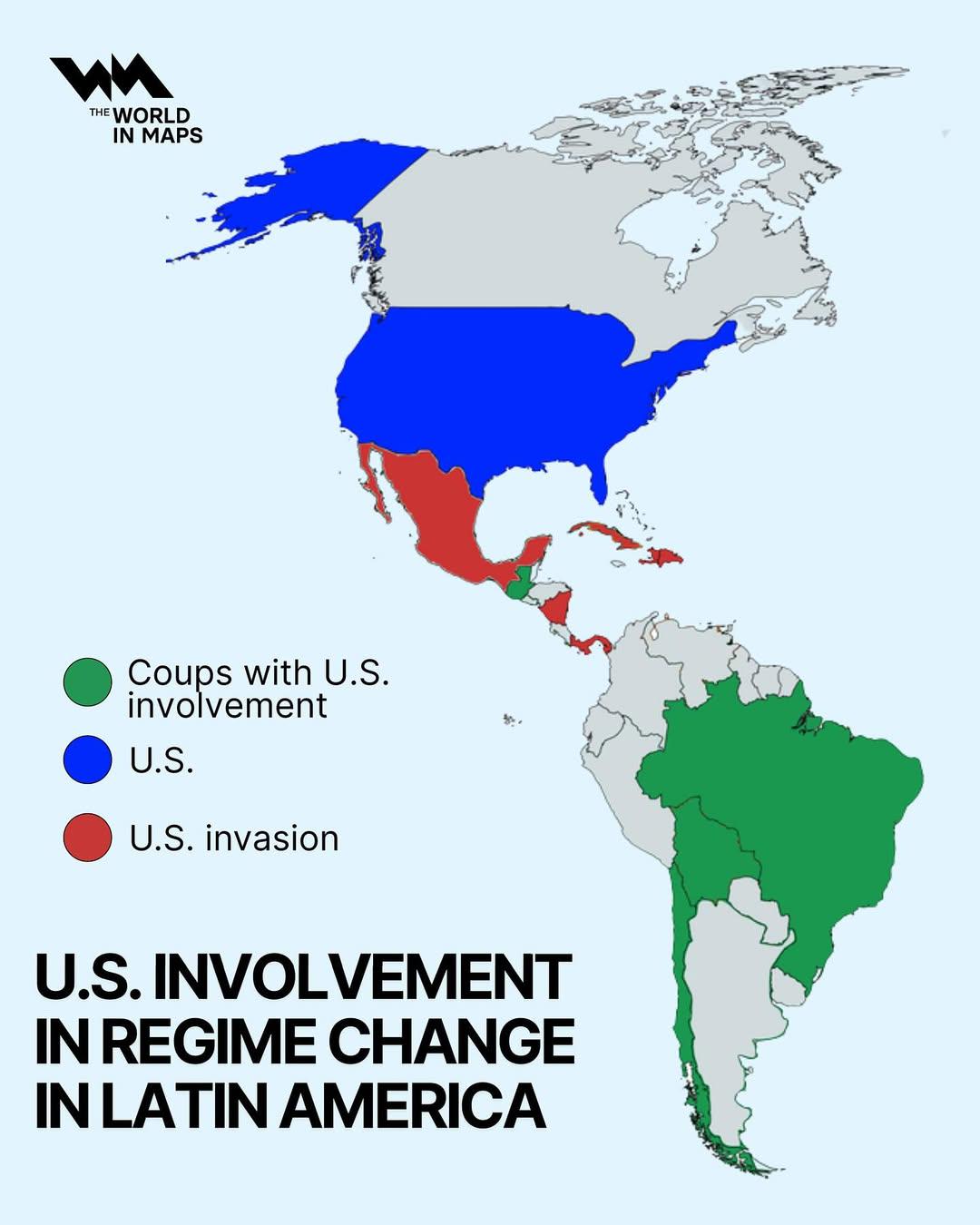US Involvement in Regime Change in Latin America Map


Marcus Rodriguez
Historical Geography Expert
Marcus Rodriguez specializes in historical cartography and geographic data analysis. With a background in both history and geography, he brings unique...
Geographic Analysis
What This Map Shows
The visualization titled "US Involvement in Regime Change in Latin America" provides a geographical representation of various instances where the United States has intervened in Latin American countries to alter or influence governance. It highlights key events, such as coups, military interventions, and significant political shifts, marking a complex relationship that has evolved over decades. While the map presents historical data, it also invites us to reflect on the broader implications of these actions on the political landscape of the region.
Deep Dive into US Involvement in Regime Change
The history of US involvement in regime change in Latin America is a tapestry woven with political intrigue, ideological battles, and national interests. Beginning in the early 20th century, the US government often justified its interventions under the guise of promoting democracy and stability, particularly during the Cold War era. For instance, the 1954 CIA-backed coup in Guatemala that overthrew a democratically elected president, Jacobo Árbenz, was framed as a necessary move against perceived communist threats.
Interestingly, the doctrine of containment motivated many of these actions. The US feared that the spread of communism in Latin America could lead to a domino effect, threatening US interests and allies globally. This led to interventions in countries like Cuba, Chile, and Nicaragua, where the US supported various factions, often including military dictatorships, to suppress leftist movements. The overthrow of Salvador Allende in Chile in 1973 is a poignant example. Allende was the first Marxist to be elected president through open elections in a country with a liberal democracy, but his governmental policies were met with fierce opposition from both domestic and international actors, leading to a violent coup supported by the US.
The impact of these interventions has been profound and multifaceted. Many of these countries experienced extended periods of political instability, human rights violations, and economic hardships. The legacy of US involvement has shaped public perception and has often left a lingering resentment toward American policy in the region. For example, in Nicaragua, the US support of the Contras against the Sandinista government resulted in a protracted civil conflict, leading to thousands of deaths and a deeply divided society.
Moreover, the repercussions of these actions continue to influence politics in Latin America today. The rise of leftist governments in the 2000s, often referred to as the 'Pink Tide,' can be seen as a reaction to historical US interventions. Countries like Venezuela and Bolivia embraced socialist ideologies partially as a means to assert sovereignty and resist perceived imperialism.
Regional Analysis
Breaking down the map, we can observe distinct regional patterns of US involvement. In Central America, countries like Guatemala and El Salvador experienced multiple interventions, reflecting the US's strategic interest in battling both communism and perceived threats to its control over the Panama Canal. The Salvadoran Civil War, supported by US funding and military aid, resulted in tens of thousands of deaths and a legacy of violence that still affects the region.
In contrast, South America's history showcases a variety of interventions, particularly in the Southern Cone. The overthrow of the Allende government in Chile and the support for Argentina's military junta during the Dirty War are stark reminders of how US interests often overshadowed democratic principles. Additionally, Bolivia's recent political turmoil can be traced back to historical US policies that have historically aimed at influencing its governance.
Interestingly, the Caribbean presents a different narrative. The Cuban Revolution led by Fidel Castro in 1959 was a direct challenge to US hegemony, resulting in a long-standing embargo and a unique relationship between the US and Cuba that diverges from the typical regime change narrative.
Significance and Impact
Understanding the map of US involvement in regime change in Latin America is crucial for grasping the complexities of international relations and the legacy of foreign policy. The implications of these historical actions extend beyond the immediate political outcomes; they have shaped national identities and regional dynamics that persist today. As Latin America continues to navigate its path, the historical context provided by this map serves as a reminder of the challenges that arise from foreign intervention.
Current trends indicate a renewed focus on sovereignty and self-determination among Latin American countries, as seen in recent movements advocating for social justice and political reform. Moving forward, it's essential for both the US and Latin American nations to reflect on this history and work toward a more equitable relationship based on mutual respect and understanding. Ever wondered how these past events shape contemporary politics? The answer lies within the very fabric of Latin American society, navigating the delicate balance of external influence and internal governance.
As we look to the future, recognizing the lessons of the past can help prevent repeating history and foster a more prosperous and democratic environment in the region. The map serves not just as a historical record, but as a call to action for a more thoughtful engagement in international relations.
Visualization Details
- Published
- September 16, 2025
- Views
- 74
Comments
Loading comments...